Nursing 11: Critical Review of a Research Paper on Chronic Diseases
VerifiedAdded on 2022/10/11
|18
|4044
|50
Report
AI Summary
This report critically reviews a research paper by Peters et al. (2014) focusing on patient-reported outcome measures (PROM) in patients with chronic diseases within the context of the NHS outcomes framework. The report begins with an introduction to evidence-based practice (EBP) and its significance in nursing, followed by a rationale for the chosen domain of the NHS outcomes framework, specifically health-related outcomes for people with long-term illnesses. The analysis and synthesis of the research paper includes an examination of the study's methodology, findings, and its correlation with the NHS outcomes framework. A detailed analysis of the chosen study is conducted using the CASP tool, evaluating the validity, results, and implications of the study. The report also discusses and justifies the effects of the study, followed by a reflection and conclusion summarizing the key findings and their implications for nursing practice and healthcare policy. The report emphasizes the importance of EBP in improving patient care and the need for further research in the effective use of PROMs for patients with long-term conditions.

Running head: NURSING
Critical Review
Name of the Student
Name of the University
Author’s Note
Critical Review
Name of the Student
Name of the University
Author’s Note
Paraphrase This Document
Need a fresh take? Get an instant paraphrase of this document with our AI Paraphraser
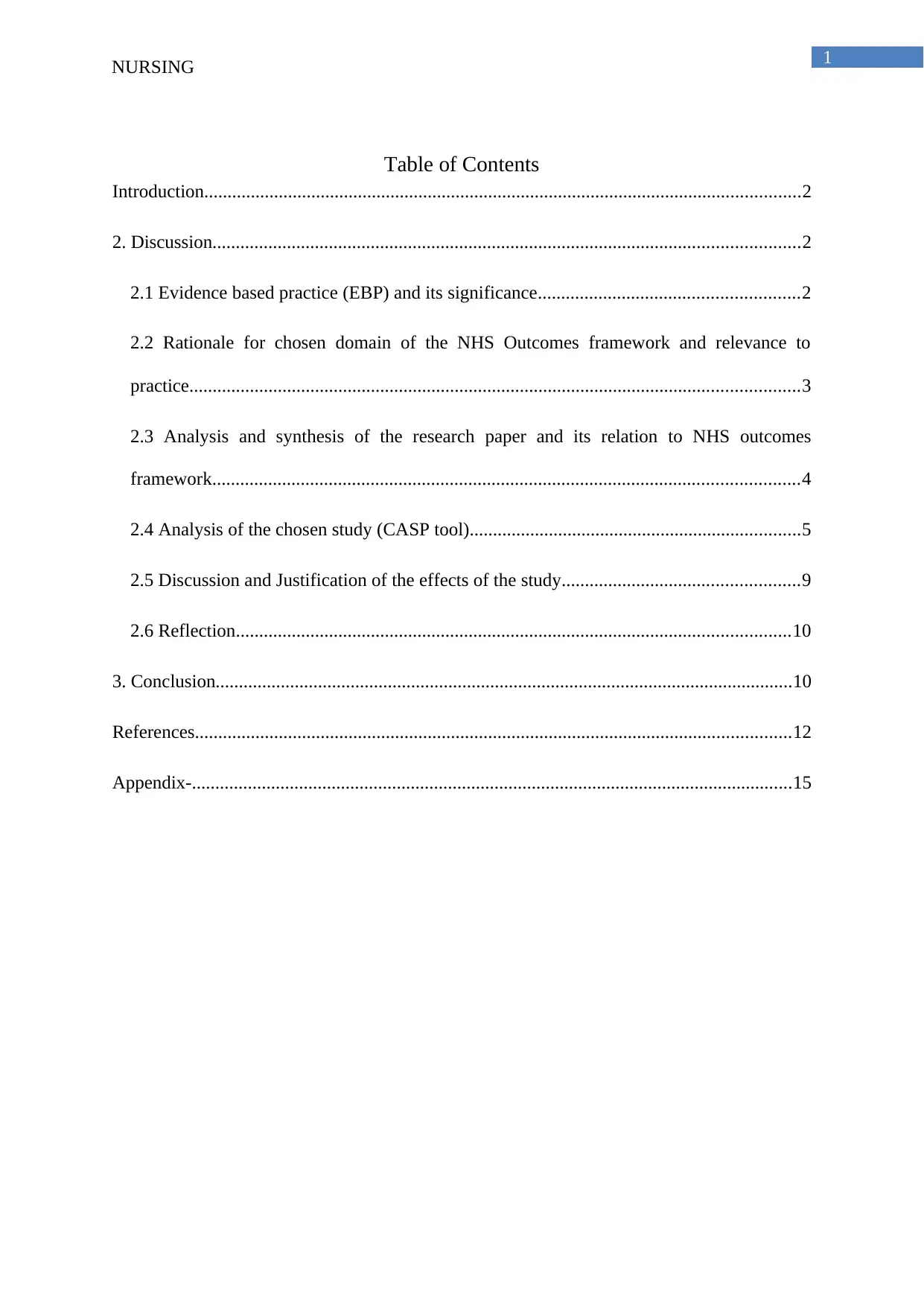
1
NURSING
Table of Contents
Introduction................................................................................................................................2
2. Discussion..............................................................................................................................2
2.1 Evidence based practice (EBP) and its significance........................................................2
2.2 Rationale for chosen domain of the NHS Outcomes framework and relevance to
practice...................................................................................................................................3
2.3 Analysis and synthesis of the research paper and its relation to NHS outcomes
framework..............................................................................................................................4
2.4 Analysis of the chosen study (CASP tool).......................................................................5
2.5 Discussion and Justification of the effects of the study...................................................9
2.6 Reflection.......................................................................................................................10
3. Conclusion............................................................................................................................10
References................................................................................................................................12
Appendix-.................................................................................................................................15
NURSING
Table of Contents
Introduction................................................................................................................................2
2. Discussion..............................................................................................................................2
2.1 Evidence based practice (EBP) and its significance........................................................2
2.2 Rationale for chosen domain of the NHS Outcomes framework and relevance to
practice...................................................................................................................................3
2.3 Analysis and synthesis of the research paper and its relation to NHS outcomes
framework..............................................................................................................................4
2.4 Analysis of the chosen study (CASP tool).......................................................................5
2.5 Discussion and Justification of the effects of the study...................................................9
2.6 Reflection.......................................................................................................................10
3. Conclusion............................................................................................................................10
References................................................................................................................................12
Appendix-.................................................................................................................................15
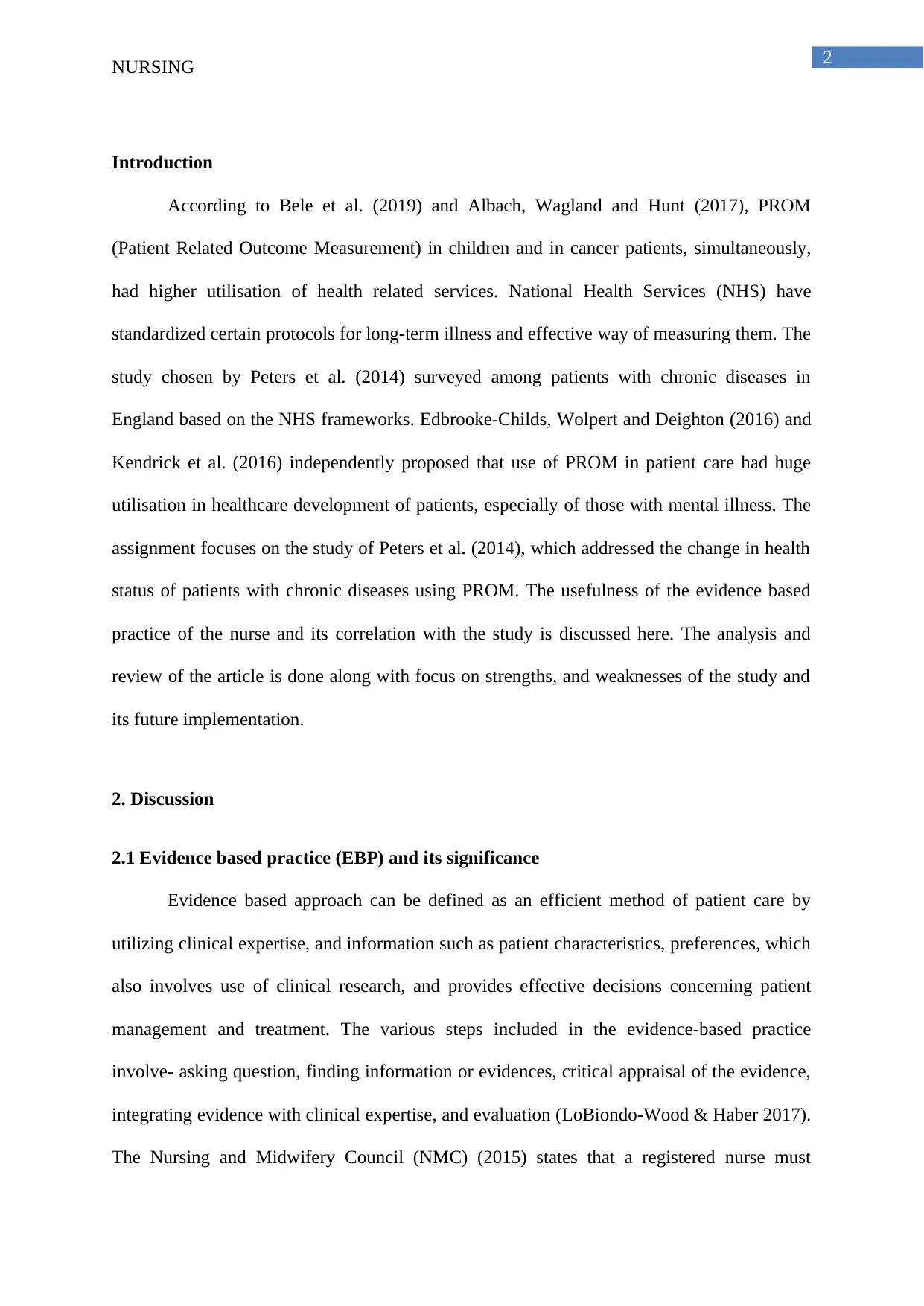
2
NURSING
Introduction
According to Bele et al. (2019) and Albach, Wagland and Hunt (2017), PROM
(Patient Related Outcome Measurement) in children and in cancer patients, simultaneously,
had higher utilisation of health related services. National Health Services (NHS) have
standardized certain protocols for long-term illness and effective way of measuring them. The
study chosen by Peters et al. (2014) surveyed among patients with chronic diseases in
England based on the NHS frameworks. Edbrooke-Childs, Wolpert and Deighton (2016) and
Kendrick et al. (2016) independently proposed that use of PROM in patient care had huge
utilisation in healthcare development of patients, especially of those with mental illness. The
assignment focuses on the study of Peters et al. (2014), which addressed the change in health
status of patients with chronic diseases using PROM. The usefulness of the evidence based
practice of the nurse and its correlation with the study is discussed here. The analysis and
review of the article is done along with focus on strengths, and weaknesses of the study and
its future implementation.
2. Discussion
2.1 Evidence based practice (EBP) and its significance
Evidence based approach can be defined as an efficient method of patient care by
utilizing clinical expertise, and information such as patient characteristics, preferences, which
also involves use of clinical research, and provides effective decisions concerning patient
management and treatment. The various steps included in the evidence-based practice
involve- asking question, finding information or evidences, critical appraisal of the evidence,
integrating evidence with clinical expertise, and evaluation (LoBiondo-Wood & Haber 2017).
The Nursing and Midwifery Council (NMC) (2015) states that a registered nurse must
NURSING
Introduction
According to Bele et al. (2019) and Albach, Wagland and Hunt (2017), PROM
(Patient Related Outcome Measurement) in children and in cancer patients, simultaneously,
had higher utilisation of health related services. National Health Services (NHS) have
standardized certain protocols for long-term illness and effective way of measuring them. The
study chosen by Peters et al. (2014) surveyed among patients with chronic diseases in
England based on the NHS frameworks. Edbrooke-Childs, Wolpert and Deighton (2016) and
Kendrick et al. (2016) independently proposed that use of PROM in patient care had huge
utilisation in healthcare development of patients, especially of those with mental illness. The
assignment focuses on the study of Peters et al. (2014), which addressed the change in health
status of patients with chronic diseases using PROM. The usefulness of the evidence based
practice of the nurse and its correlation with the study is discussed here. The analysis and
review of the article is done along with focus on strengths, and weaknesses of the study and
its future implementation.
2. Discussion
2.1 Evidence based practice (EBP) and its significance
Evidence based approach can be defined as an efficient method of patient care by
utilizing clinical expertise, and information such as patient characteristics, preferences, which
also involves use of clinical research, and provides effective decisions concerning patient
management and treatment. The various steps included in the evidence-based practice
involve- asking question, finding information or evidences, critical appraisal of the evidence,
integrating evidence with clinical expertise, and evaluation (LoBiondo-Wood & Haber 2017).
The Nursing and Midwifery Council (NMC) (2015) states that a registered nurse must
⊘ This is a preview!⊘
Do you want full access?
Subscribe today to unlock all pages.

Trusted by 1+ million students worldwide
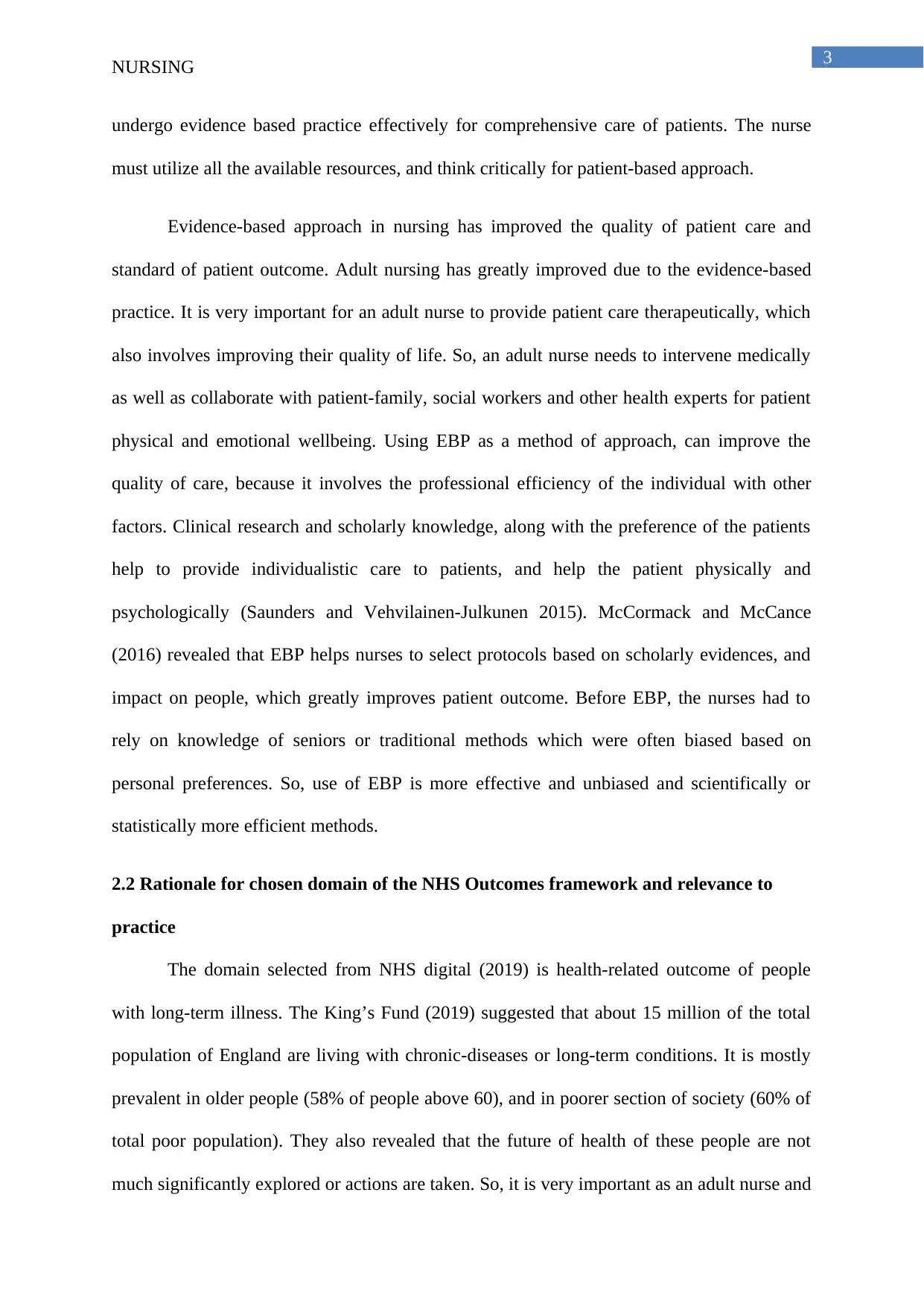
3
NURSING
undergo evidence based practice effectively for comprehensive care of patients. The nurse
must utilize all the available resources, and think critically for patient-based approach.
Evidence-based approach in nursing has improved the quality of patient care and
standard of patient outcome. Adult nursing has greatly improved due to the evidence-based
practice. It is very important for an adult nurse to provide patient care therapeutically, which
also involves improving their quality of life. So, an adult nurse needs to intervene medically
as well as collaborate with patient-family, social workers and other health experts for patient
physical and emotional wellbeing. Using EBP as a method of approach, can improve the
quality of care, because it involves the professional efficiency of the individual with other
factors. Clinical research and scholarly knowledge, along with the preference of the patients
help to provide individualistic care to patients, and help the patient physically and
psychologically (Saunders and Vehvilainen-Julkunen 2015). McCormack and McCance
(2016) revealed that EBP helps nurses to select protocols based on scholarly evidences, and
impact on people, which greatly improves patient outcome. Before EBP, the nurses had to
rely on knowledge of seniors or traditional methods which were often biased based on
personal preferences. So, use of EBP is more effective and unbiased and scientifically or
statistically more efficient methods.
2.2 Rationale for chosen domain of the NHS Outcomes framework and relevance to
practice
The domain selected from NHS digital (2019) is health-related outcome of people
with long-term illness. The King’s Fund (2019) suggested that about 15 million of the total
population of England are living with chronic-diseases or long-term conditions. It is mostly
prevalent in older people (58% of people above 60), and in poorer section of society (60% of
total poor population). They also revealed that the future of health of these people are not
much significantly explored or actions are taken. So, it is very important as an adult nurse and
NURSING
undergo evidence based practice effectively for comprehensive care of patients. The nurse
must utilize all the available resources, and think critically for patient-based approach.
Evidence-based approach in nursing has improved the quality of patient care and
standard of patient outcome. Adult nursing has greatly improved due to the evidence-based
practice. It is very important for an adult nurse to provide patient care therapeutically, which
also involves improving their quality of life. So, an adult nurse needs to intervene medically
as well as collaborate with patient-family, social workers and other health experts for patient
physical and emotional wellbeing. Using EBP as a method of approach, can improve the
quality of care, because it involves the professional efficiency of the individual with other
factors. Clinical research and scholarly knowledge, along with the preference of the patients
help to provide individualistic care to patients, and help the patient physically and
psychologically (Saunders and Vehvilainen-Julkunen 2015). McCormack and McCance
(2016) revealed that EBP helps nurses to select protocols based on scholarly evidences, and
impact on people, which greatly improves patient outcome. Before EBP, the nurses had to
rely on knowledge of seniors or traditional methods which were often biased based on
personal preferences. So, use of EBP is more effective and unbiased and scientifically or
statistically more efficient methods.
2.2 Rationale for chosen domain of the NHS Outcomes framework and relevance to
practice
The domain selected from NHS digital (2019) is health-related outcome of people
with long-term illness. The King’s Fund (2019) suggested that about 15 million of the total
population of England are living with chronic-diseases or long-term conditions. It is mostly
prevalent in older people (58% of people above 60), and in poorer section of society (60% of
total poor population). They also revealed that the future of health of these people are not
much significantly explored or actions are taken. So, it is very important as an adult nurse and
Paraphrase This Document
Need a fresh take? Get an instant paraphrase of this document with our AI Paraphraser
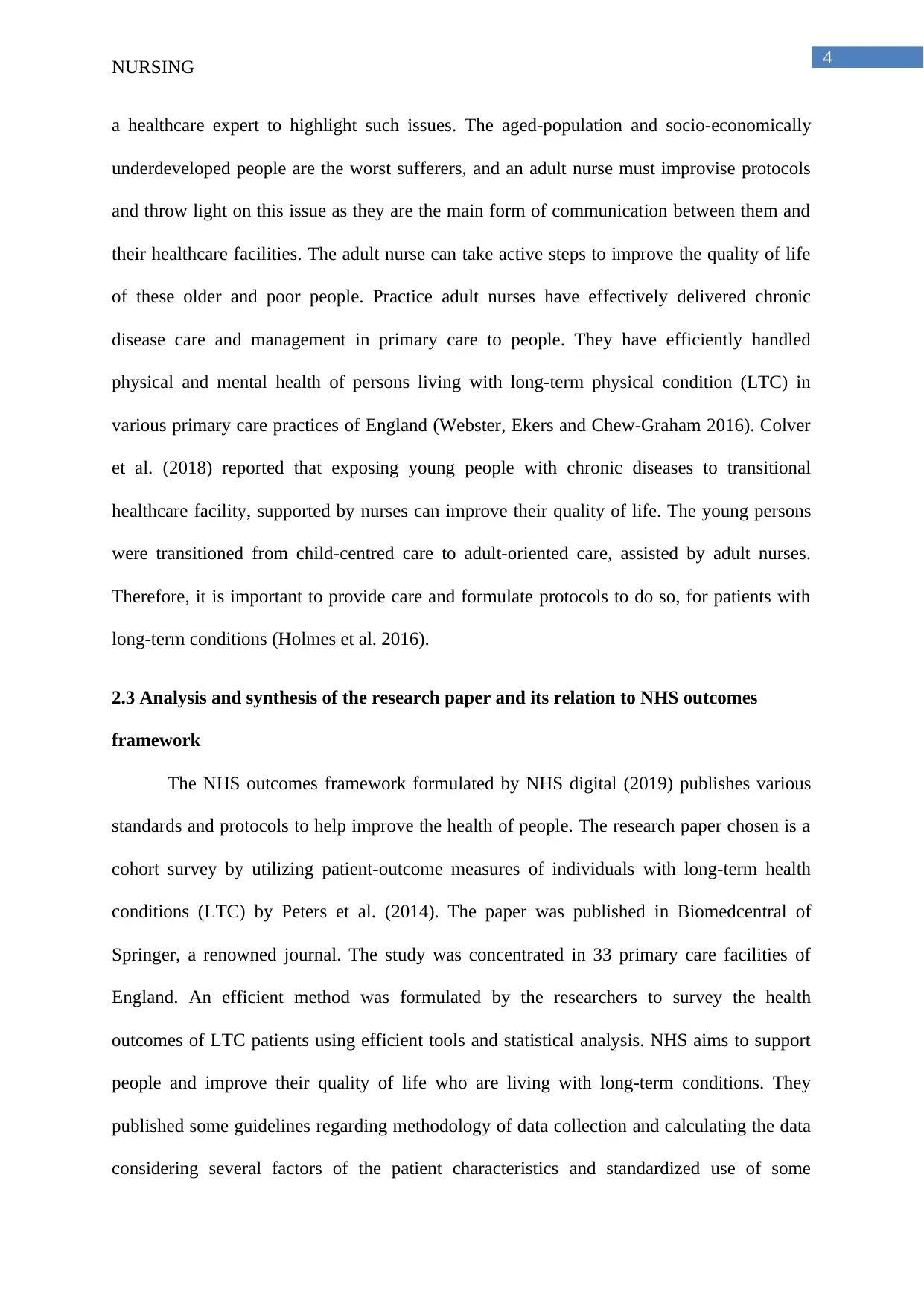
4
NURSING
a healthcare expert to highlight such issues. The aged-population and socio-economically
underdeveloped people are the worst sufferers, and an adult nurse must improvise protocols
and throw light on this issue as they are the main form of communication between them and
their healthcare facilities. The adult nurse can take active steps to improve the quality of life
of these older and poor people. Practice adult nurses have effectively delivered chronic
disease care and management in primary care to people. They have efficiently handled
physical and mental health of persons living with long-term physical condition (LTC) in
various primary care practices of England (Webster, Ekers and Chew-Graham 2016). Colver
et al. (2018) reported that exposing young people with chronic diseases to transitional
healthcare facility, supported by nurses can improve their quality of life. The young persons
were transitioned from child-centred care to adult-oriented care, assisted by adult nurses.
Therefore, it is important to provide care and formulate protocols to do so, for patients with
long-term conditions (Holmes et al. 2016).
2.3 Analysis and synthesis of the research paper and its relation to NHS outcomes
framework
The NHS outcomes framework formulated by NHS digital (2019) publishes various
standards and protocols to help improve the health of people. The research paper chosen is a
cohort survey by utilizing patient-outcome measures of individuals with long-term health
conditions (LTC) by Peters et al. (2014). The paper was published in Biomedcentral of
Springer, a renowned journal. The study was concentrated in 33 primary care facilities of
England. An efficient method was formulated by the researchers to survey the health
outcomes of LTC patients using efficient tools and statistical analysis. NHS aims to support
people and improve their quality of life who are living with long-term conditions. They
published some guidelines regarding methodology of data collection and calculating the data
considering several factors of the patient characteristics and standardized use of some
NURSING
a healthcare expert to highlight such issues. The aged-population and socio-economically
underdeveloped people are the worst sufferers, and an adult nurse must improvise protocols
and throw light on this issue as they are the main form of communication between them and
their healthcare facilities. The adult nurse can take active steps to improve the quality of life
of these older and poor people. Practice adult nurses have effectively delivered chronic
disease care and management in primary care to people. They have efficiently handled
physical and mental health of persons living with long-term physical condition (LTC) in
various primary care practices of England (Webster, Ekers and Chew-Graham 2016). Colver
et al. (2018) reported that exposing young people with chronic diseases to transitional
healthcare facility, supported by nurses can improve their quality of life. The young persons
were transitioned from child-centred care to adult-oriented care, assisted by adult nurses.
Therefore, it is important to provide care and formulate protocols to do so, for patients with
long-term conditions (Holmes et al. 2016).
2.3 Analysis and synthesis of the research paper and its relation to NHS outcomes
framework
The NHS outcomes framework formulated by NHS digital (2019) publishes various
standards and protocols to help improve the health of people. The research paper chosen is a
cohort survey by utilizing patient-outcome measures of individuals with long-term health
conditions (LTC) by Peters et al. (2014). The paper was published in Biomedcentral of
Springer, a renowned journal. The study was concentrated in 33 primary care facilities of
England. An efficient method was formulated by the researchers to survey the health
outcomes of LTC patients using efficient tools and statistical analysis. NHS aims to support
people and improve their quality of life who are living with long-term conditions. They
published some guidelines regarding methodology of data collection and calculating the data
considering several factors of the patient characteristics and standardized use of some
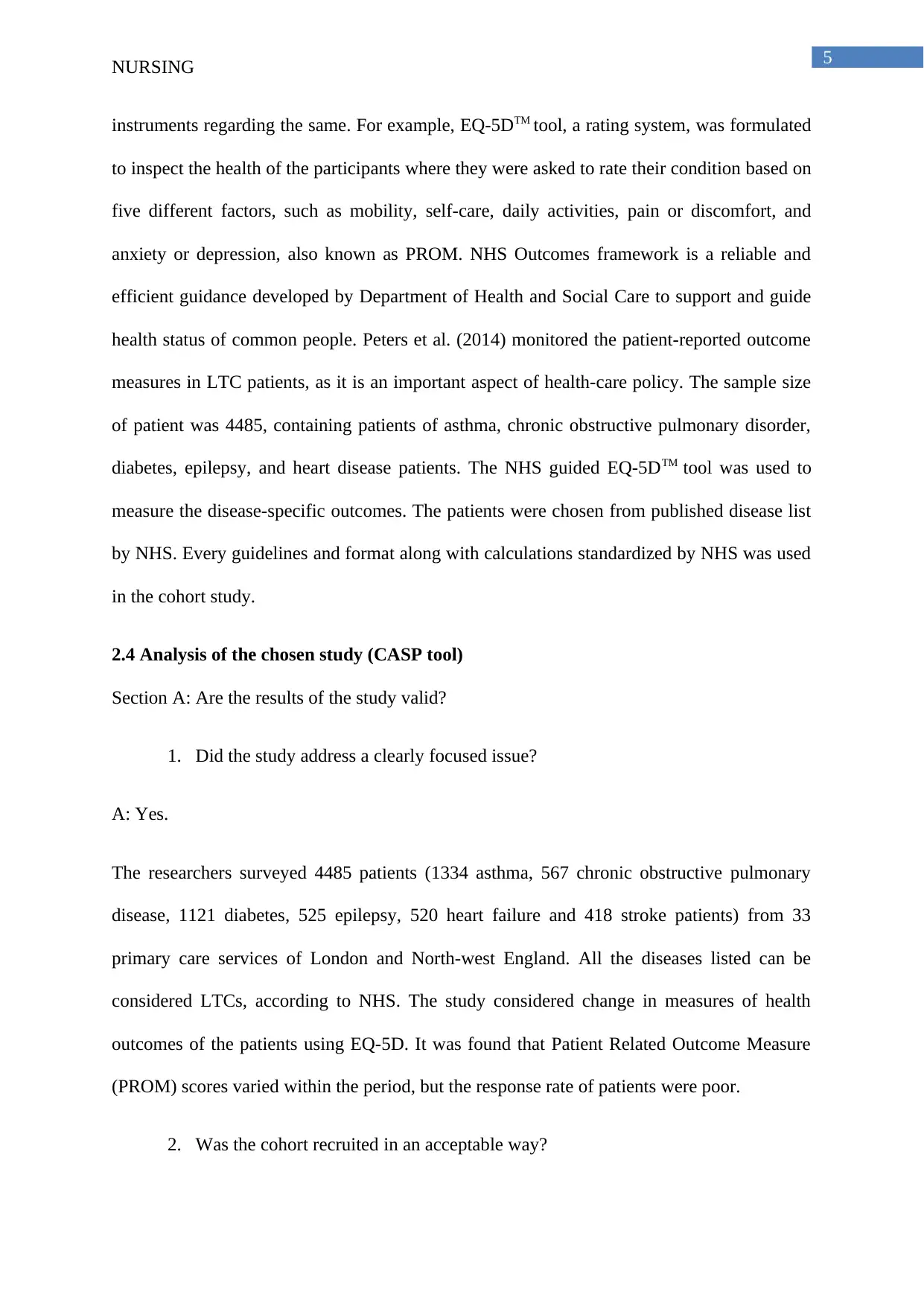
5
NURSING
instruments regarding the same. For example, EQ-5DTM tool, a rating system, was formulated
to inspect the health of the participants where they were asked to rate their condition based on
five different factors, such as mobility, self-care, daily activities, pain or discomfort, and
anxiety or depression, also known as PROM. NHS Outcomes framework is a reliable and
efficient guidance developed by Department of Health and Social Care to support and guide
health status of common people. Peters et al. (2014) monitored the patient-reported outcome
measures in LTC patients, as it is an important aspect of health-care policy. The sample size
of patient was 4485, containing patients of asthma, chronic obstructive pulmonary disorder,
diabetes, epilepsy, and heart disease patients. The NHS guided EQ-5DTM tool was used to
measure the disease-specific outcomes. The patients were chosen from published disease list
by NHS. Every guidelines and format along with calculations standardized by NHS was used
in the cohort study.
2.4 Analysis of the chosen study (CASP tool)
Section A: Are the results of the study valid?
1. Did the study address a clearly focused issue?
A: Yes.
The researchers surveyed 4485 patients (1334 asthma, 567 chronic obstructive pulmonary
disease, 1121 diabetes, 525 epilepsy, 520 heart failure and 418 stroke patients) from 33
primary care services of London and North-west England. All the diseases listed can be
considered LTCs, according to NHS. The study considered change in measures of health
outcomes of the patients using EQ-5D. It was found that Patient Related Outcome Measure
(PROM) scores varied within the period, but the response rate of patients were poor.
2. Was the cohort recruited in an acceptable way?
NURSING
instruments regarding the same. For example, EQ-5DTM tool, a rating system, was formulated
to inspect the health of the participants where they were asked to rate their condition based on
five different factors, such as mobility, self-care, daily activities, pain or discomfort, and
anxiety or depression, also known as PROM. NHS Outcomes framework is a reliable and
efficient guidance developed by Department of Health and Social Care to support and guide
health status of common people. Peters et al. (2014) monitored the patient-reported outcome
measures in LTC patients, as it is an important aspect of health-care policy. The sample size
of patient was 4485, containing patients of asthma, chronic obstructive pulmonary disorder,
diabetes, epilepsy, and heart disease patients. The NHS guided EQ-5DTM tool was used to
measure the disease-specific outcomes. The patients were chosen from published disease list
by NHS. Every guidelines and format along with calculations standardized by NHS was used
in the cohort study.
2.4 Analysis of the chosen study (CASP tool)
Section A: Are the results of the study valid?
1. Did the study address a clearly focused issue?
A: Yes.
The researchers surveyed 4485 patients (1334 asthma, 567 chronic obstructive pulmonary
disease, 1121 diabetes, 525 epilepsy, 520 heart failure and 418 stroke patients) from 33
primary care services of London and North-west England. All the diseases listed can be
considered LTCs, according to NHS. The study considered change in measures of health
outcomes of the patients using EQ-5D. It was found that Patient Related Outcome Measure
(PROM) scores varied within the period, but the response rate of patients were poor.
2. Was the cohort recruited in an acceptable way?
⊘ This is a preview!⊘
Do you want full access?
Subscribe today to unlock all pages.

Trusted by 1+ million students worldwide
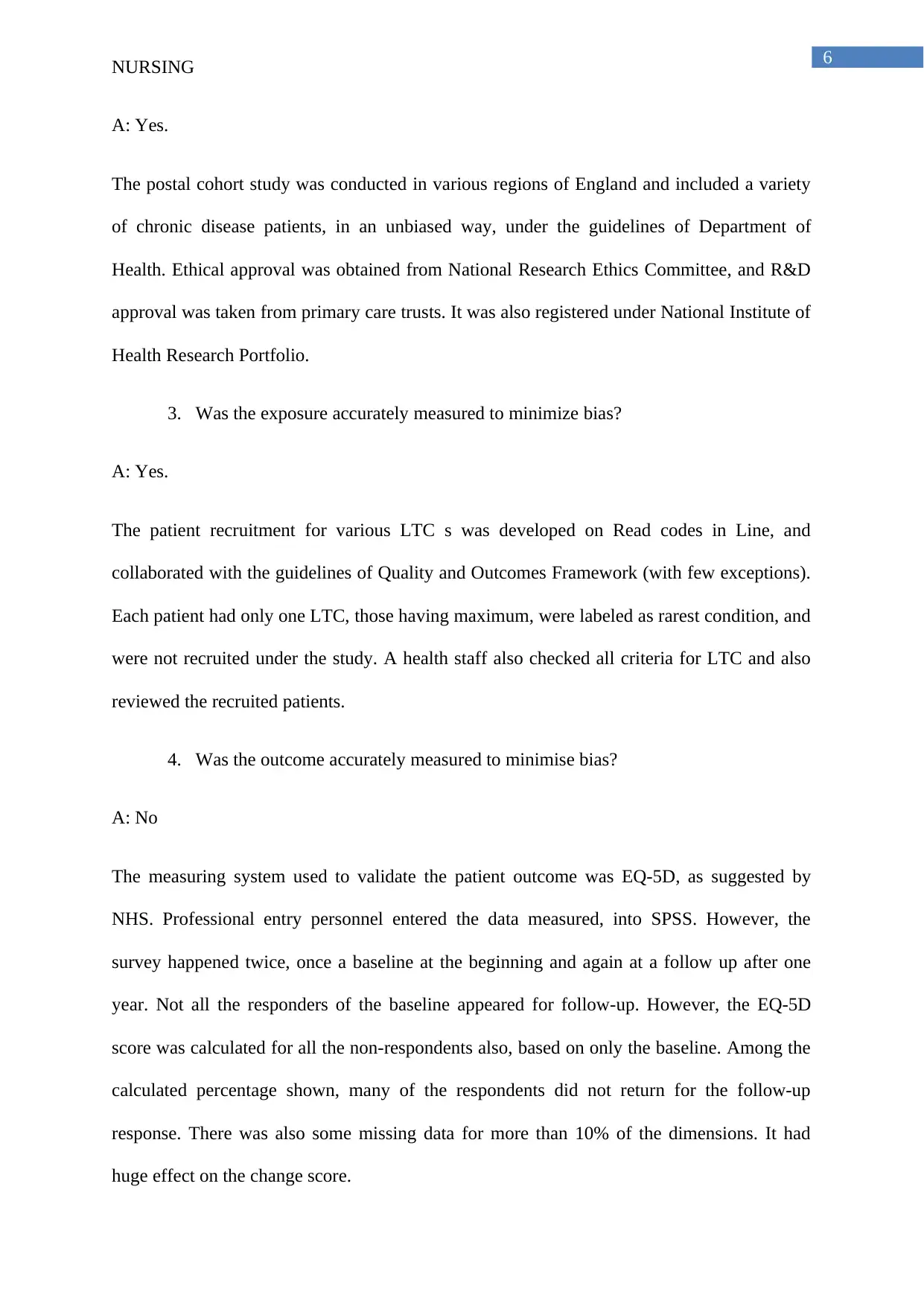
6
NURSING
A: Yes.
The postal cohort study was conducted in various regions of England and included a variety
of chronic disease patients, in an unbiased way, under the guidelines of Department of
Health. Ethical approval was obtained from National Research Ethics Committee, and R&D
approval was taken from primary care trusts. It was also registered under National Institute of
Health Research Portfolio.
3. Was the exposure accurately measured to minimize bias?
A: Yes.
The patient recruitment for various LTC s was developed on Read codes in Line, and
collaborated with the guidelines of Quality and Outcomes Framework (with few exceptions).
Each patient had only one LTC, those having maximum, were labeled as rarest condition, and
were not recruited under the study. A health staff also checked all criteria for LTC and also
reviewed the recruited patients.
4. Was the outcome accurately measured to minimise bias?
A: No
The measuring system used to validate the patient outcome was EQ-5D, as suggested by
NHS. Professional entry personnel entered the data measured, into SPSS. However, the
survey happened twice, once a baseline at the beginning and again at a follow up after one
year. Not all the responders of the baseline appeared for follow-up. However, the EQ-5D
score was calculated for all the non-respondents also, based on only the baseline. Among the
calculated percentage shown, many of the respondents did not return for the follow-up
response. There was also some missing data for more than 10% of the dimensions. It had
huge effect on the change score.
NURSING
A: Yes.
The postal cohort study was conducted in various regions of England and included a variety
of chronic disease patients, in an unbiased way, under the guidelines of Department of
Health. Ethical approval was obtained from National Research Ethics Committee, and R&D
approval was taken from primary care trusts. It was also registered under National Institute of
Health Research Portfolio.
3. Was the exposure accurately measured to minimize bias?
A: Yes.
The patient recruitment for various LTC s was developed on Read codes in Line, and
collaborated with the guidelines of Quality and Outcomes Framework (with few exceptions).
Each patient had only one LTC, those having maximum, were labeled as rarest condition, and
were not recruited under the study. A health staff also checked all criteria for LTC and also
reviewed the recruited patients.
4. Was the outcome accurately measured to minimise bias?
A: No
The measuring system used to validate the patient outcome was EQ-5D, as suggested by
NHS. Professional entry personnel entered the data measured, into SPSS. However, the
survey happened twice, once a baseline at the beginning and again at a follow up after one
year. Not all the responders of the baseline appeared for follow-up. However, the EQ-5D
score was calculated for all the non-respondents also, based on only the baseline. Among the
calculated percentage shown, many of the respondents did not return for the follow-up
response. There was also some missing data for more than 10% of the dimensions. It had
huge effect on the change score.
Paraphrase This Document
Need a fresh take? Get an instant paraphrase of this document with our AI Paraphraser
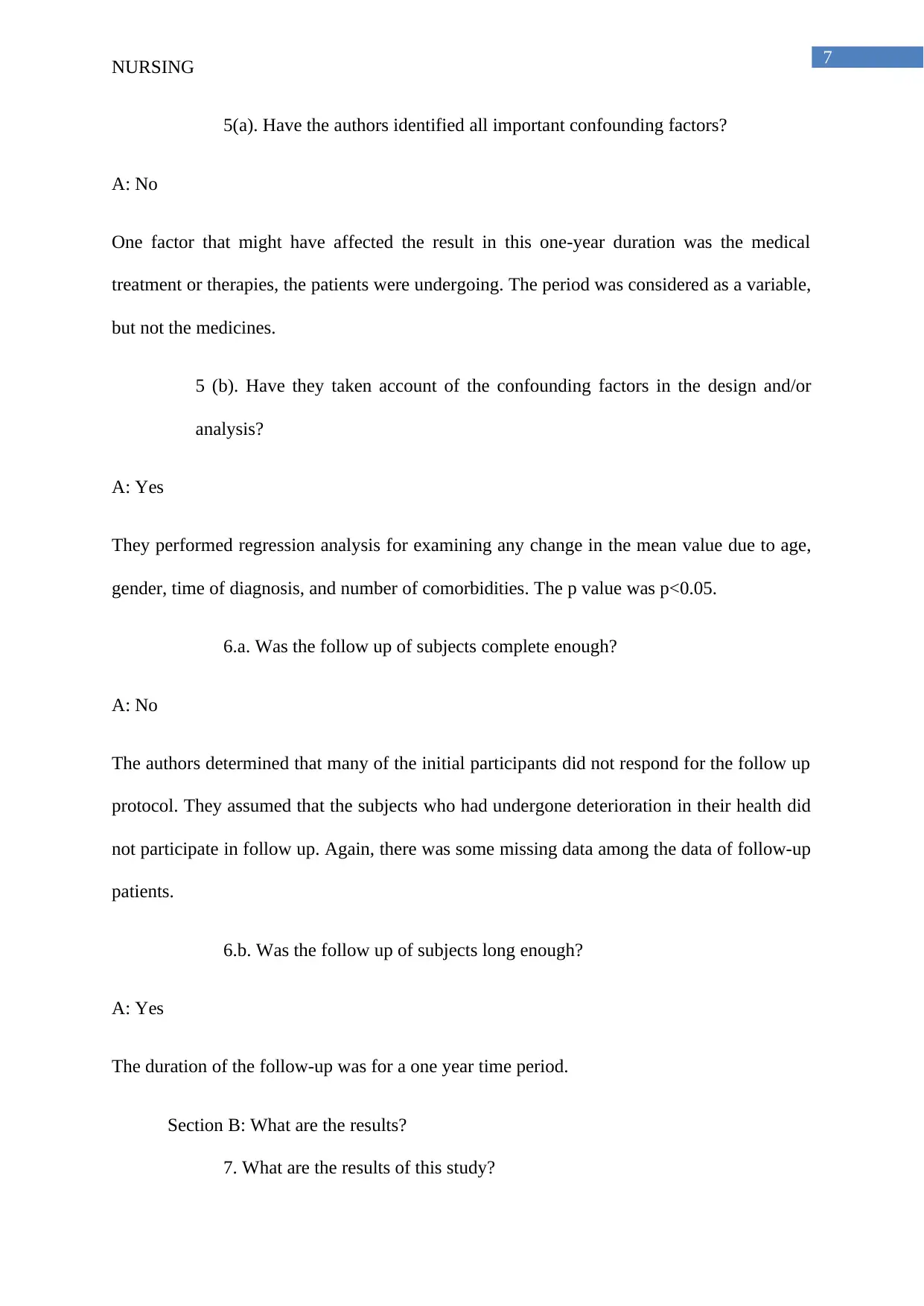
7
NURSING
5(a). Have the authors identified all important confounding factors?
A: No
One factor that might have affected the result in this one-year duration was the medical
treatment or therapies, the patients were undergoing. The period was considered as a variable,
but not the medicines.
5 (b). Have they taken account of the confounding factors in the design and/or
analysis?
A: Yes
They performed regression analysis for examining any change in the mean value due to age,
gender, time of diagnosis, and number of comorbidities. The p value was p<0.05.
6.a. Was the follow up of subjects complete enough?
A: No
The authors determined that many of the initial participants did not respond for the follow up
protocol. They assumed that the subjects who had undergone deterioration in their health did
not participate in follow up. Again, there was some missing data among the data of follow-up
patients.
6.b. Was the follow up of subjects long enough?
A: Yes
The duration of the follow-up was for a one year time period.
Section B: What are the results?
7. What are the results of this study?
NURSING
5(a). Have the authors identified all important confounding factors?
A: No
One factor that might have affected the result in this one-year duration was the medical
treatment or therapies, the patients were undergoing. The period was considered as a variable,
but not the medicines.
5 (b). Have they taken account of the confounding factors in the design and/or
analysis?
A: Yes
They performed regression analysis for examining any change in the mean value due to age,
gender, time of diagnosis, and number of comorbidities. The p value was p<0.05.
6.a. Was the follow up of subjects complete enough?
A: No
The authors determined that many of the initial participants did not respond for the follow up
protocol. They assumed that the subjects who had undergone deterioration in their health did
not participate in follow up. Again, there was some missing data among the data of follow-up
patients.
6.b. Was the follow up of subjects long enough?
A: Yes
The duration of the follow-up was for a one year time period.
Section B: What are the results?
7. What are the results of this study?
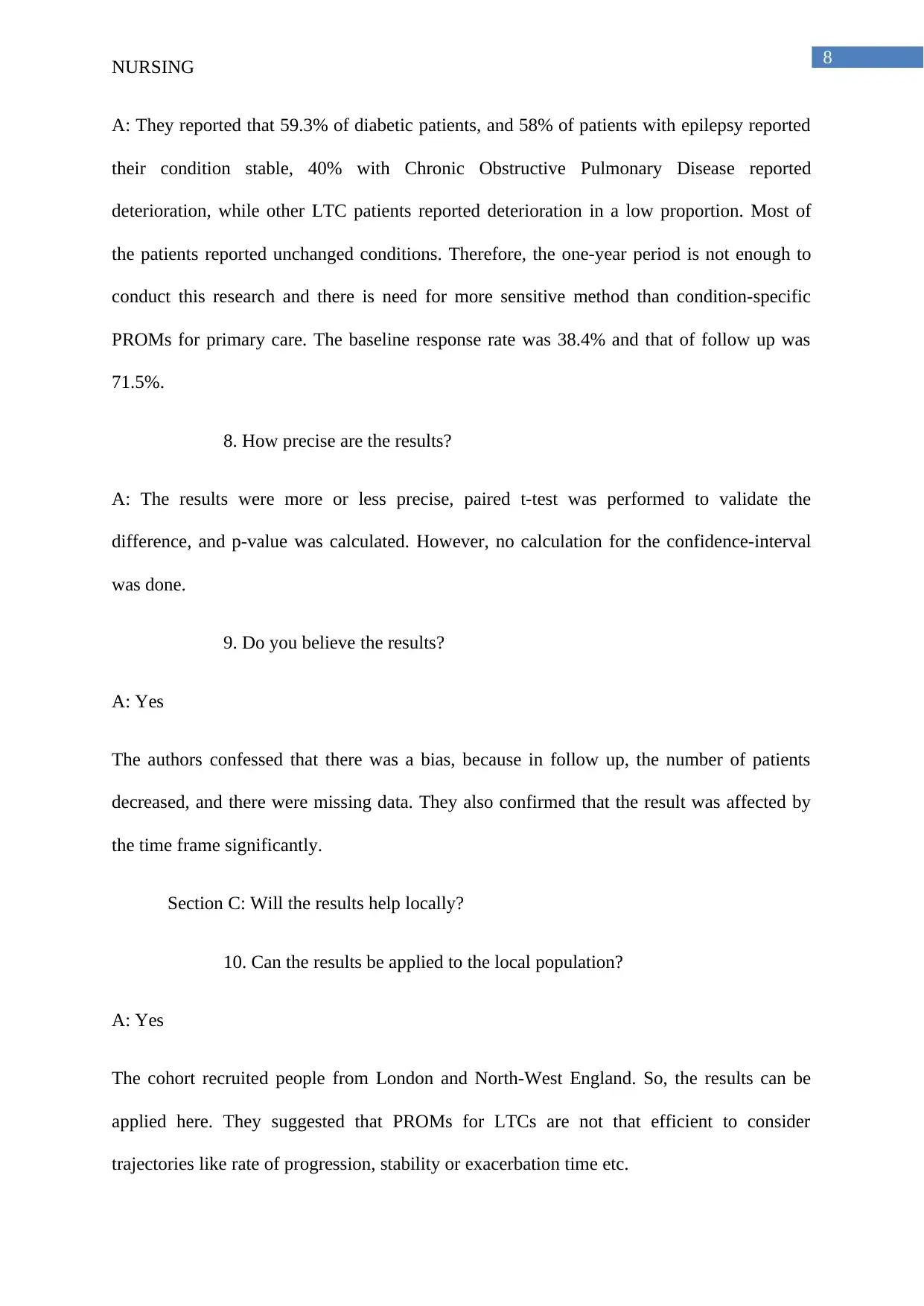
8
NURSING
A: They reported that 59.3% of diabetic patients, and 58% of patients with epilepsy reported
their condition stable, 40% with Chronic Obstructive Pulmonary Disease reported
deterioration, while other LTC patients reported deterioration in a low proportion. Most of
the patients reported unchanged conditions. Therefore, the one-year period is not enough to
conduct this research and there is need for more sensitive method than condition-specific
PROMs for primary care. The baseline response rate was 38.4% and that of follow up was
71.5%.
8. How precise are the results?
A: The results were more or less precise, paired t-test was performed to validate the
difference, and p-value was calculated. However, no calculation for the confidence-interval
was done.
9. Do you believe the results?
A: Yes
The authors confessed that there was a bias, because in follow up, the number of patients
decreased, and there were missing data. They also confirmed that the result was affected by
the time frame significantly.
Section C: Will the results help locally?
10. Can the results be applied to the local population?
A: Yes
The cohort recruited people from London and North-West England. So, the results can be
applied here. They suggested that PROMs for LTCs are not that efficient to consider
trajectories like rate of progression, stability or exacerbation time etc.
NURSING
A: They reported that 59.3% of diabetic patients, and 58% of patients with epilepsy reported
their condition stable, 40% with Chronic Obstructive Pulmonary Disease reported
deterioration, while other LTC patients reported deterioration in a low proportion. Most of
the patients reported unchanged conditions. Therefore, the one-year period is not enough to
conduct this research and there is need for more sensitive method than condition-specific
PROMs for primary care. The baseline response rate was 38.4% and that of follow up was
71.5%.
8. How precise are the results?
A: The results were more or less precise, paired t-test was performed to validate the
difference, and p-value was calculated. However, no calculation for the confidence-interval
was done.
9. Do you believe the results?
A: Yes
The authors confessed that there was a bias, because in follow up, the number of patients
decreased, and there were missing data. They also confirmed that the result was affected by
the time frame significantly.
Section C: Will the results help locally?
10. Can the results be applied to the local population?
A: Yes
The cohort recruited people from London and North-West England. So, the results can be
applied here. They suggested that PROMs for LTCs are not that efficient to consider
trajectories like rate of progression, stability or exacerbation time etc.
⊘ This is a preview!⊘
Do you want full access?
Subscribe today to unlock all pages.

Trusted by 1+ million students worldwide
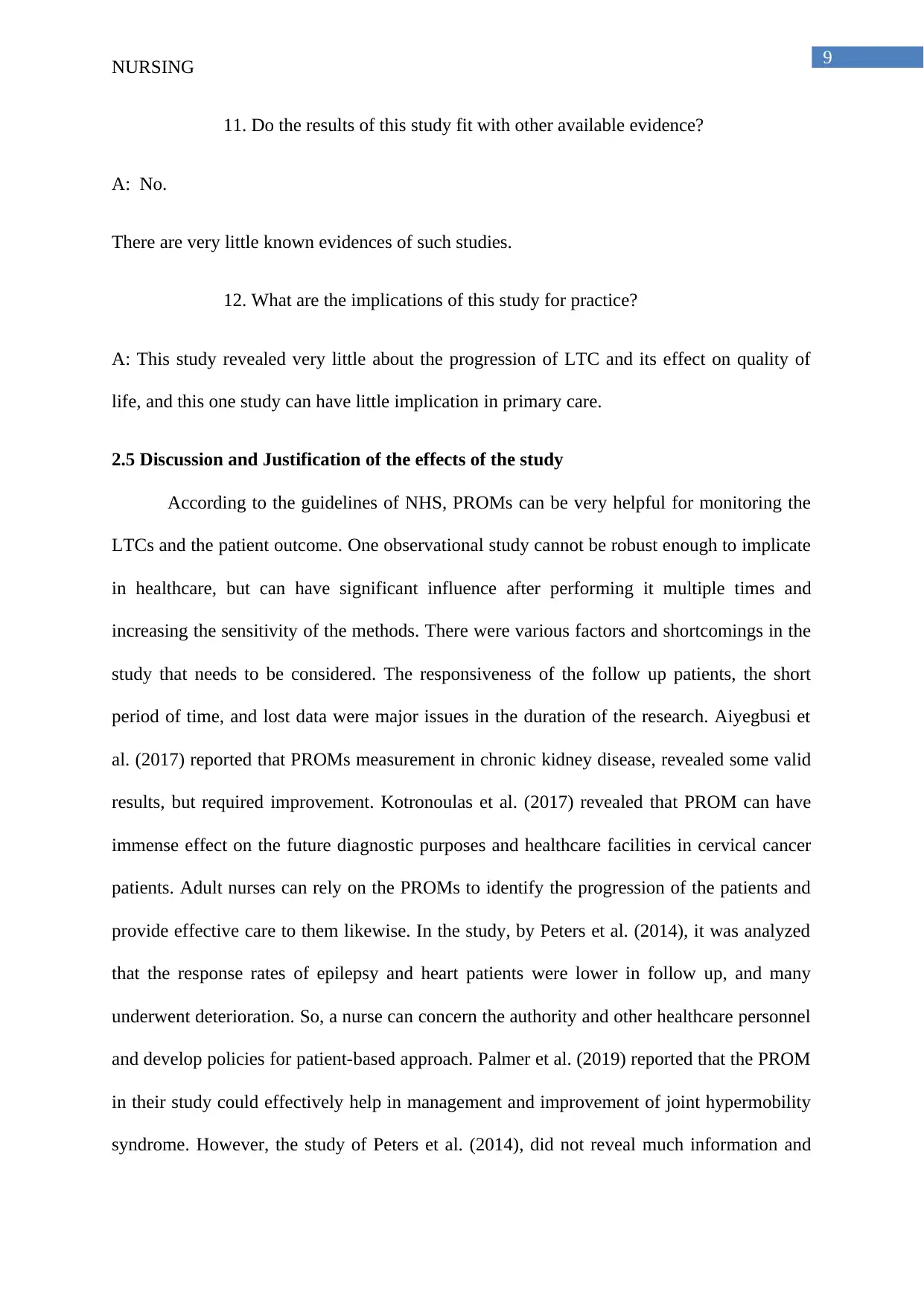
9
NURSING
11. Do the results of this study fit with other available evidence?
A: No.
There are very little known evidences of such studies.
12. What are the implications of this study for practice?
A: This study revealed very little about the progression of LTC and its effect on quality of
life, and this one study can have little implication in primary care.
2.5 Discussion and Justification of the effects of the study
According to the guidelines of NHS, PROMs can be very helpful for monitoring the
LTCs and the patient outcome. One observational study cannot be robust enough to implicate
in healthcare, but can have significant influence after performing it multiple times and
increasing the sensitivity of the methods. There were various factors and shortcomings in the
study that needs to be considered. The responsiveness of the follow up patients, the short
period of time, and lost data were major issues in the duration of the research. Aiyegbusi et
al. (2017) reported that PROMs measurement in chronic kidney disease, revealed some valid
results, but required improvement. Kotronoulas et al. (2017) revealed that PROM can have
immense effect on the future diagnostic purposes and healthcare facilities in cervical cancer
patients. Adult nurses can rely on the PROMs to identify the progression of the patients and
provide effective care to them likewise. In the study, by Peters et al. (2014), it was analyzed
that the response rates of epilepsy and heart patients were lower in follow up, and many
underwent deterioration. So, a nurse can concern the authority and other healthcare personnel
and develop policies for patient-based approach. Palmer et al. (2019) reported that the PROM
in their study could effectively help in management and improvement of joint hypermobility
syndrome. However, the study of Peters et al. (2014), did not reveal much information and
NURSING
11. Do the results of this study fit with other available evidence?
A: No.
There are very little known evidences of such studies.
12. What are the implications of this study for practice?
A: This study revealed very little about the progression of LTC and its effect on quality of
life, and this one study can have little implication in primary care.
2.5 Discussion and Justification of the effects of the study
According to the guidelines of NHS, PROMs can be very helpful for monitoring the
LTCs and the patient outcome. One observational study cannot be robust enough to implicate
in healthcare, but can have significant influence after performing it multiple times and
increasing the sensitivity of the methods. There were various factors and shortcomings in the
study that needs to be considered. The responsiveness of the follow up patients, the short
period of time, and lost data were major issues in the duration of the research. Aiyegbusi et
al. (2017) reported that PROMs measurement in chronic kidney disease, revealed some valid
results, but required improvement. Kotronoulas et al. (2017) revealed that PROM can have
immense effect on the future diagnostic purposes and healthcare facilities in cervical cancer
patients. Adult nurses can rely on the PROMs to identify the progression of the patients and
provide effective care to them likewise. In the study, by Peters et al. (2014), it was analyzed
that the response rates of epilepsy and heart patients were lower in follow up, and many
underwent deterioration. So, a nurse can concern the authority and other healthcare personnel
and develop policies for patient-based approach. Palmer et al. (2019) reported that the PROM
in their study could effectively help in management and improvement of joint hypermobility
syndrome. However, the study of Peters et al. (2014), did not reveal much information and
Paraphrase This Document
Need a fresh take? Get an instant paraphrase of this document with our AI Paraphraser
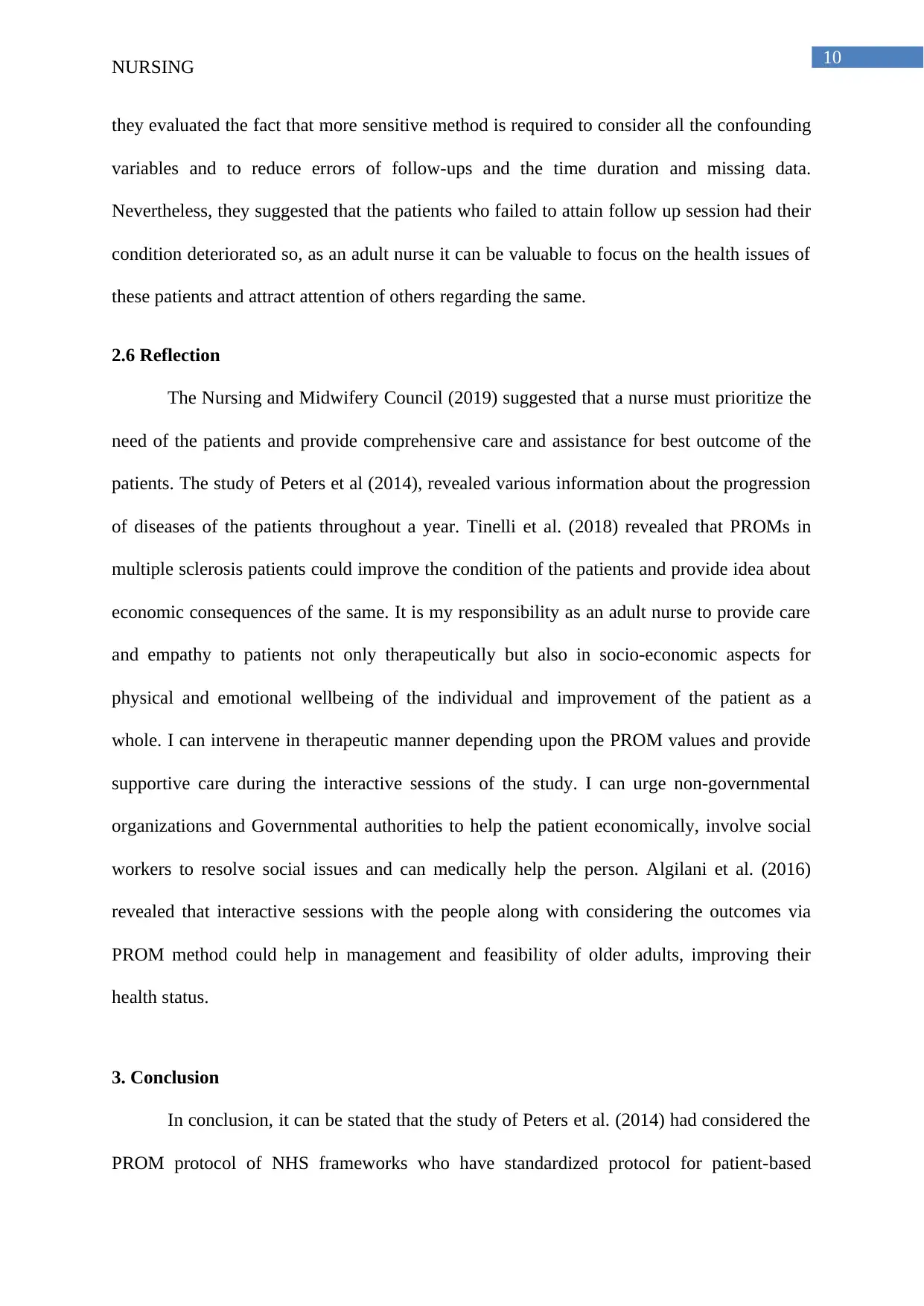
10
NURSING
they evaluated the fact that more sensitive method is required to consider all the confounding
variables and to reduce errors of follow-ups and the time duration and missing data.
Nevertheless, they suggested that the patients who failed to attain follow up session had their
condition deteriorated so, as an adult nurse it can be valuable to focus on the health issues of
these patients and attract attention of others regarding the same.
2.6 Reflection
The Nursing and Midwifery Council (2019) suggested that a nurse must prioritize the
need of the patients and provide comprehensive care and assistance for best outcome of the
patients. The study of Peters et al (2014), revealed various information about the progression
of diseases of the patients throughout a year. Tinelli et al. (2018) revealed that PROMs in
multiple sclerosis patients could improve the condition of the patients and provide idea about
economic consequences of the same. It is my responsibility as an adult nurse to provide care
and empathy to patients not only therapeutically but also in socio-economic aspects for
physical and emotional wellbeing of the individual and improvement of the patient as a
whole. I can intervene in therapeutic manner depending upon the PROM values and provide
supportive care during the interactive sessions of the study. I can urge non-governmental
organizations and Governmental authorities to help the patient economically, involve social
workers to resolve social issues and can medically help the person. Algilani et al. (2016)
revealed that interactive sessions with the people along with considering the outcomes via
PROM method could help in management and feasibility of older adults, improving their
health status.
3. Conclusion
In conclusion, it can be stated that the study of Peters et al. (2014) had considered the
PROM protocol of NHS frameworks who have standardized protocol for patient-based
NURSING
they evaluated the fact that more sensitive method is required to consider all the confounding
variables and to reduce errors of follow-ups and the time duration and missing data.
Nevertheless, they suggested that the patients who failed to attain follow up session had their
condition deteriorated so, as an adult nurse it can be valuable to focus on the health issues of
these patients and attract attention of others regarding the same.
2.6 Reflection
The Nursing and Midwifery Council (2019) suggested that a nurse must prioritize the
need of the patients and provide comprehensive care and assistance for best outcome of the
patients. The study of Peters et al (2014), revealed various information about the progression
of diseases of the patients throughout a year. Tinelli et al. (2018) revealed that PROMs in
multiple sclerosis patients could improve the condition of the patients and provide idea about
economic consequences of the same. It is my responsibility as an adult nurse to provide care
and empathy to patients not only therapeutically but also in socio-economic aspects for
physical and emotional wellbeing of the individual and improvement of the patient as a
whole. I can intervene in therapeutic manner depending upon the PROM values and provide
supportive care during the interactive sessions of the study. I can urge non-governmental
organizations and Governmental authorities to help the patient economically, involve social
workers to resolve social issues and can medically help the person. Algilani et al. (2016)
revealed that interactive sessions with the people along with considering the outcomes via
PROM method could help in management and feasibility of older adults, improving their
health status.
3. Conclusion
In conclusion, it can be stated that the study of Peters et al. (2014) had considered the
PROM protocol of NHS frameworks who have standardized protocol for patient-based
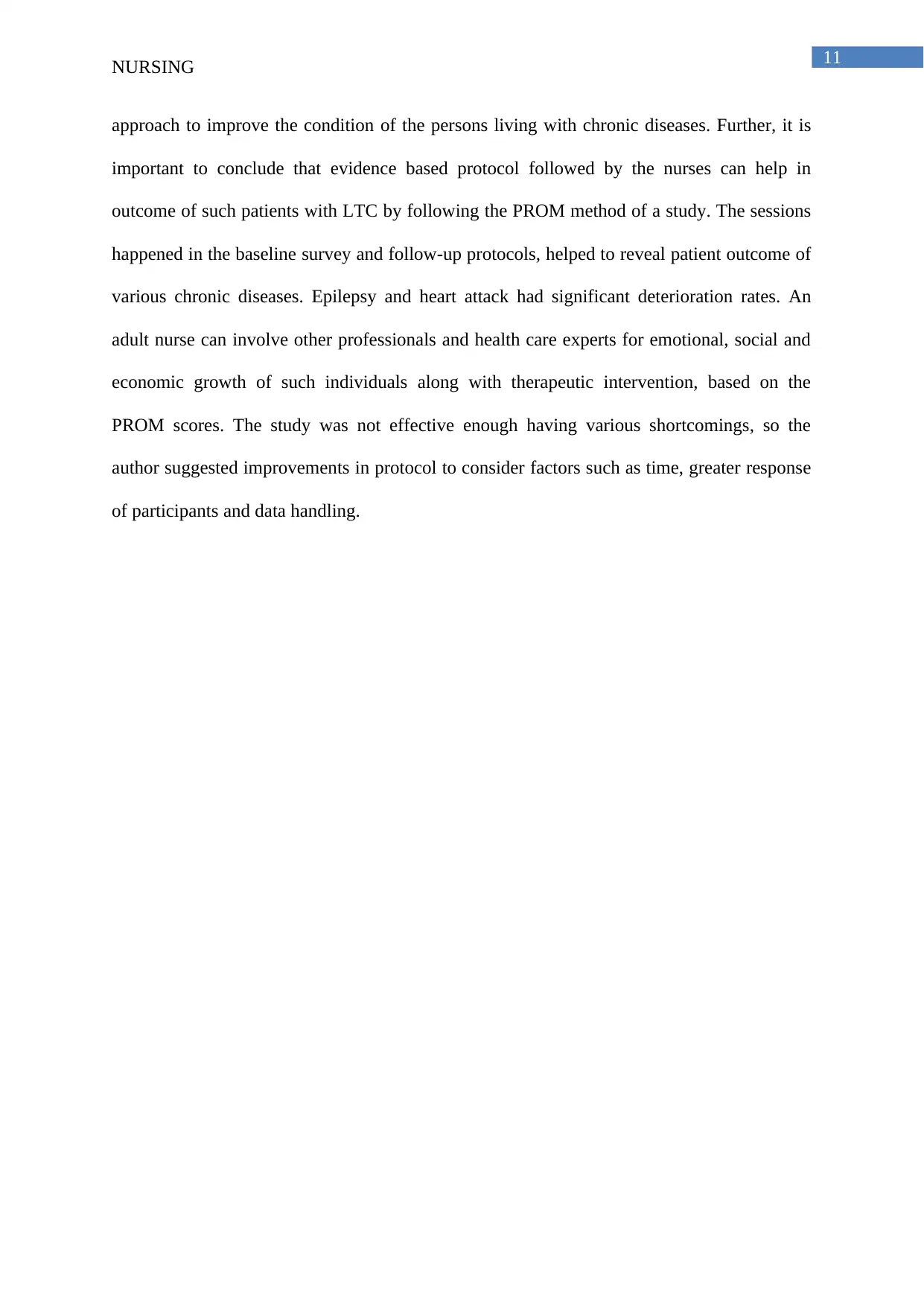
11
NURSING
approach to improve the condition of the persons living with chronic diseases. Further, it is
important to conclude that evidence based protocol followed by the nurses can help in
outcome of such patients with LTC by following the PROM method of a study. The sessions
happened in the baseline survey and follow-up protocols, helped to reveal patient outcome of
various chronic diseases. Epilepsy and heart attack had significant deterioration rates. An
adult nurse can involve other professionals and health care experts for emotional, social and
economic growth of such individuals along with therapeutic intervention, based on the
PROM scores. The study was not effective enough having various shortcomings, so the
author suggested improvements in protocol to consider factors such as time, greater response
of participants and data handling.
NURSING
approach to improve the condition of the persons living with chronic diseases. Further, it is
important to conclude that evidence based protocol followed by the nurses can help in
outcome of such patients with LTC by following the PROM method of a study. The sessions
happened in the baseline survey and follow-up protocols, helped to reveal patient outcome of
various chronic diseases. Epilepsy and heart attack had significant deterioration rates. An
adult nurse can involve other professionals and health care experts for emotional, social and
economic growth of such individuals along with therapeutic intervention, based on the
PROM scores. The study was not effective enough having various shortcomings, so the
author suggested improvements in protocol to consider factors such as time, greater response
of participants and data handling.
⊘ This is a preview!⊘
Do you want full access?
Subscribe today to unlock all pages.

Trusted by 1+ million students worldwide
1 out of 18
Related Documents
Your All-in-One AI-Powered Toolkit for Academic Success.
+13062052269
info@desklib.com
Available 24*7 on WhatsApp / Email
![[object Object]](/_next/static/media/star-bottom.7253800d.svg)
Unlock your academic potential
Copyright © 2020–2025 A2Z Services. All Rights Reserved. Developed and managed by ZUCOL.





